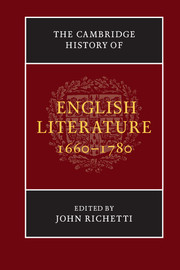Book contents
- Frontmatter
- Introduction
- PART I LITERARY PRODUCTION AND DISSEMINATION: CHANGING AUDIENCES AND EMERGING MEDIA
- PART II LITERARY GENRES: ADAPTATION AND REFORMATION
- PART III LITERATURE AND INTELLECTUAL LIFE: THE PRODUCTION AND TRANSMISSION OF CULTURE
- PART IV LITERATURE AND SOCIAL AND INSTITUTIONAL CHANGE
- PART V LITERARY GENRES: TRANSFORMATION AND NEW FORMS OF EXPRESSIVENESS
- 24 Personal letters
- 25 Diary and autobiography
- 26 The Gothic novel
- 27 Eighteenth-century travel literature
- 28 Women novelists 1740s–1780s
- 29 Burke and the uses of eloquence: political prose in the 1770s and 1780s
- PART VI CONCLUSION
- Chronology
- Bibliographies
- Index
- References
28 - Women novelists 1740s–1780s
from PART V - LITERARY GENRES: TRANSFORMATION AND NEW FORMS OF EXPRESSIVENESS
Published online by Cambridge University Press: 28 March 2008
- Frontmatter
- Introduction
- PART I LITERARY PRODUCTION AND DISSEMINATION: CHANGING AUDIENCES AND EMERGING MEDIA
- PART II LITERARY GENRES: ADAPTATION AND REFORMATION
- PART III LITERATURE AND INTELLECTUAL LIFE: THE PRODUCTION AND TRANSMISSION OF CULTURE
- PART IV LITERATURE AND SOCIAL AND INSTITUTIONAL CHANGE
- PART V LITERARY GENRES: TRANSFORMATION AND NEW FORMS OF EXPRESSIVENESS
- 24 Personal letters
- 25 Diary and autobiography
- 26 The Gothic novel
- 27 Eighteenth-century travel literature
- 28 Women novelists 1740s–1780s
- 29 Burke and the uses of eloquence: political prose in the 1770s and 1780s
- PART VI CONCLUSION
- Chronology
- Bibliographies
- Index
- References
Summary
In Jane Austen's Northanger Abbey Catherine Morland and her friend Isabella share a mutual passion for reading novels in spite of the fact that ‘no species of composition has been so much decried’. When caught reading a novel, a typical young lady of the period, we are told, might blurt out in embarrassment, ‘Oh! It is only a novel!’ quickly putting it aside: ‘It is only Cecilia, or Camilla, or Belinda.’ Yet in defence of the genre, Austen's narrator remarks that a novel is ‘only some work in which the greatest powers of the mind are displayed, in which the most thorough knowledge of human nature, the happiest delineation of its varieties, the liveliest effusions of wit and humour are conveyed to the world in the best-chosen language’. Until recently literary scholars, rather than assenting to Austen's ironic appreciation of Frances Burney and Maria Edgeworth, have sometimes shared the young woman's attitude of ‘affected indifference, or momentary shame’ in taking pleasure in novel reading. In spite of critical reticence, recent attention to eighteenth-century women authors and readers has transformed the understanding of the English novel in the mid and late eighteenth century. Widely read by their contemporaries, these women and others like them had largely been lost to the literary history of the first half of the twentieth century. In fact, women novelists, except for Burney and Austen, were omitted from consideration in the previous edition of The Cambridge History of English Literature.
- Type
- Chapter
- Information
- The Cambridge History of English Literature, 1660–1780 , pp. 745 - 767Publisher: Cambridge University PressPrint publication year: 2005

